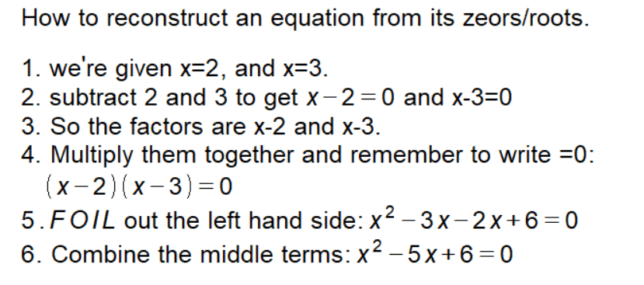Reconstructing an Equation from Zeros/Roots
Learn the step-by-step process to rebuild a quadratic equation from its given roots. This guide is ideal for students and educators seeking to understand the fundamentals of algebra.
- We’re given roots at
x = 2, andx = 3. - Subtract the roots from
xto getx − 2 = 0andx − 3 = 0. - The factors derived from the roots are
x − 2andx − 3. - Multiply the factors:
(x − 2)(x − 3) = 0. - Apply the FOIL method on the left hand side:
x² − 3x − 2x + 6 = 0. - Combine like terms to get the final equation:
x² − 5x + 6 = 0.
Understanding the relationship between roots and the quadratic equation enhances problem-solving skills in algebra.
Formulating a Quadratic Equation from Roots
Learn the process of creating a quadratic equation from specific roots. This guide simplifies algebraic concepts for educational purposes.
- Given the roots:
x = -1andx = 2. - Convert roots to factors by changing the sign:
x + 1 = 0andx - 2 = 0. - The corresponding factors are:
(x + 1)and(x - 2). - Multiply the factors to form the equation:
(x + 1)(x - 2) = 0. - Expand using distribution:
x² - 2x + x - 2 = 0. - Simplify by combining like terms:
x² - x - 2 = 0.
Mastering the technique of forming equations from roots is essential for solving algebraic problems effectively.
Creating a Quadratic Equation from Fractional and Whole Roots
A stepwise guide to derive a quadratic equation from roots, including a fractional root. Ideal for educational insights into quadratic constructions.
- Given roots:
x = 1/2andx = 3. - Rewrite the fractional root as
2x = 1leading to2x - 1 = 0. - For the whole root, write the factor as
x - 3 = 0. - The factors corresponding to the roots are:
(2x - 1)and(x - 3). - Multiply these factors to get the equation:
(2x - 1)(x - 3) = 0. - Expand the product:
2x² - 6x - x + 3 = 0. - Combine like terms to simplify:
2x² - 7x + 3 = 0.
Understanding how to handle fractional roots is crucial for algebraic proficiency and problem-solving accuracy.
Deriving a Quadratic Equation from Fractional Roots
This tutorial demonstrates the construction of a quadratic equation from roots that are fractions, providing a clear method for students to follow.
- Start with the roots:
x = -1/2andx = 2/3. - For the root
x = -1/2, multiply by 2 to clear the fraction:2x = -1, leading to the factor2x + 1 = 0. - For the root
x = 2/3, multiply by 3 to clear the fraction:3x = 2, which gives the factor3x - 2 = 0. - The equation is formed by the product of these factors:
(2x + 1)(3x - 2) = 0. - Expand the factors:
2x(3x) + 2x(-2) + 1(3x) - 1(2) = 0, which simplifies to6x² - 4x + 3x - 2 = 0. - Combine the like terms to finalize the equation:
6x² - x - 2 = 0.
Grasping the concept of forming equations from fractional roots is vital for comprehensive algebraic problem-solving.
Constructing a Quadratic Equation from General Fractional Roots
A guide for forming a quadratic equation from roots expressed as fractions. This method is crucial for algebraic skills development.
- Given the fractional roots:
x = a/bandy = c/d. - Eliminate the fractions by multiplying each root by its denominator to find integer-equivalent expressions:
bx = aleading tobx - a = 0, anddy = cleading tody - c = 0. - The factors corresponding to the roots are:
(bx - a)and(dy - c). - The quadratic equation is formed by the product of these factors:
(bx - a)(dy - c) = 0. - Expand the product to form the equation:
bxdy - bxc - ady + ac = 0. - For a standard quadratic form, divide through by the common denominator
bdif necessary, resulting in:x² - (ac + bd)x + ac = 0, after simplifying and collecting like terms.
This general approach is adaptable to any fractional roots and is a foundational technique in algebra.


